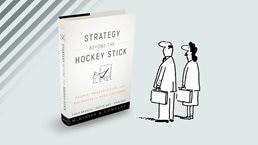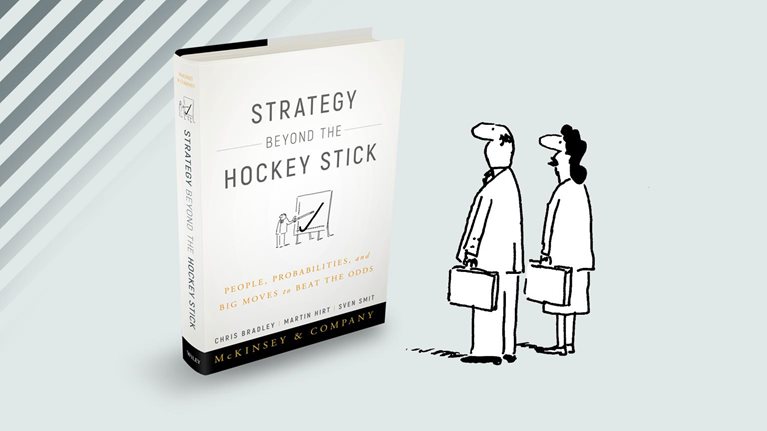Several times a year, top management teams enter the strategy room with lofty goals and the best of intentions: they hope to assess their situation and prospects honestly, and mount a decisive, coordinated response toward a common ambition.
Then reality intrudes. By the time they get to the strategy room, they find it is already crowded with egos and competing agendas. Jobs—even careers—are on the line, so caution reigns. The budget process intervenes, too. You may be discussing a five-year strategy, but everyone knows that what really matters is the first-year budget. So, many managers try to secure resources for the coming year while deferring other tough choices as far as possible into the future. One outcome of these dynamics is the hockey-stick projection, confidently showing future success after the all-too-familiar dip in next year’s budget. If we had to choose an emblem for strategic planning, this would be it.
In our book, Strategy Beyond the Hockey Stick (Wiley, February 2018), we set out to help companies unlock the big moves needed to beat the odds. Another strategy framework? No, we already have plenty of those. Rather, we need to address the real problem: the “social side of strategy,” arising from corporate politics, individual incentives, and human biases. How? With evidence. We examined publicly available information on dozens of variables for thousands of companies and found a manageable number of levers that explain more than 80 percent of the up-drift and down-drift in corporate performance. That data can help you assess your strategy’s odds of success before you leave the strategy room, much less start to execute the plan.
Such an assessment stands in stark contrast to the norms prevailing in most strategy rooms, where discussion focuses on comparisons with last year, on immediate competitors, and on expectations for the year ahead. There is also precious little room for uncertainty, for exploration of the world beyond the experience of the people in the room, or for bold strategies embracing big moves that can deliver a strong performance jolt. The result? Incremental improvements that leave companies merely playing along with the rest of their industries.
Common as that outcome is, it isn’t a necessary one. If you understand the social side of strategy, the odds of strategy revealed by our research, and the power of making big moves, you will dramatically increase your chances of success.
Would you like to learn more about our Strategy & Corporate Finance Practice?
The social side of strategy
Nobel laureate Daniel Kahneman described in his book Thinking, Fast and Slow the “inside view” that often emerges when we focus only on the case at hand. This view leads people to extrapolate from their own experiences and data, even when they are attempting something they’ve never done before. The inside view also is vulnerable to contamination by overconfidence and other cognitive biases, as well as by internal politics.
It’s well known by now that people are prone to a wide range of biases such as anchoring, loss aversion, confirmation bias, and attribution error. While these unintentional mental shortcuts help us filter information in our daily lives, they distort the outcomes when we are forced to make big, consequential decisions infrequently and under high uncertainty—exactly the types of decisions we confront in the strategy room. When you bring together people with shared experiences and goals, they wind up telling themselves stories, generally favorable ones. A study found, for instance, that 80 percent of executives believe their product stands out against the competition—but only 8 percent of customers agree.1
Then, add agency problems, and the strategy process creates a veritable petri dish for all sorts of dysfunctions to grow.2 Presenters seeking to get that all-important “yes” to their plans may define market share so it excludes geographies or segments where their business units are weak, or attribute weak performance to one-off events such as weather, restructuring efforts, or a regulatory change. Executives argue for a large resource allotment in the full knowledge that they will get negotiated down to half of that. Egos, careers, bonuses, and status in the organization all depend to a large extent on how convincingly people present their strategies and the prospects of their business.
That’s why people often “sandbag” to avoid risky moves and make triple sure they can hit their targets. Or they play the short game, focusing on performance in the next couple of years in the knowledge that they likely won’t be running their division afterward. Emblematic of these strategy-room dynamics is the hockey-stick presentation. Hockey sticks recur with alarming frequency, as the experience of a multinational company, whose disguised results appear in Exhibit 1, demonstrates. The company planned for a breakout in 2011, only to achieve flat results. Undeterred, the team drew another hockey stick for 2012, then 2013, then 2014, then 2015, even as actual results stayed roughly flat, then trailed off.

To move beyond hockey sticks and the social forces that cause them, the CEO and the board need an objective, external benchmark.
The odds of strategy
The starting point for developing such a benchmark is embracing the fact that business strategy, at its heart, is about beating the market; that is, defying the power of “perfect” markets to push economic surplus to zero. Economic profit—the total profit after the cost of capital is subtracted—measures the success of that defiance by showing what is left after the forces of competition have played out. From 2010 to 2014, the average company in our database of the world’s 2,393 largest corporations reported $920 million in annual operating profit. To make this profit, they used $9,300 million of invested capital,3 which earned a return of 9.9 percent. After investors and lenders took 8 percent to compensate for use of their funds, that left $180 million in economic profit.
Plotting each company’s average economic profit demonstrates a power law—the tails of the curve rise and fall at exponential rates, with long flatlands in the middle (Exhibit 2). The power curve reveals a number of important insights:

- Market forces are pretty efficient. The average company in our sample generates returns that exceed the cost of capital by almost two percentage points, but the market is chipping away at those profits. That brutal competition is why you struggle just to stay in place. For companies in the middle of the power curve, the market takes a heavy toll. Companies in those three quintiles delivered economic profits averaging just $47 million a year.
- The curve is extremely steep at the bookends. Companies in the top quintile capture nearly 90 percent of the economic profit created, averaging $1.4 billion annually. In fact, those in the top quintile average some 30 times as much economic profit as those in the middle three quintiles, while the bottom 20 percent suffer deep economic losses. That unevenness exists within the top quintile, too. The top 2 percent together earn about as much as the next 8 percent combined. At the other end of the curve, the undersea canyon of negative economic profit is deep—though not quite as deep as the mountain is high.
- The curve is getting steeper. Back in 2000–04, companies in the top quintile captured a collective $186 billion in economic profit. Fast forward a decade and the top quintile earned $684 billion. A similar pattern emerges in the bottom quintile. Since investors seek out companies that offer market-beating returns, capital tends to flow to the top, no matter the geographic or industry boundaries. Companies that started in the top quintile ten years earlier soaked up 50 cents of every dollar of new capital in the decade up to 2014.
- Size isn’t everything, but it isn’t nothing, either. Economic profit reflects the strength of a strategy based not only on the power of its economic formula (measured by the spread of its returns over its cost of capital) but also on how scalable that formula is (measured by how much invested capital it could deploy). Compare Walmart, with a moderate 12 percent return on capital but a whopping $136 billion of invested capital, with Starbucks, which has a huge 50 percent return on capital but is limited by being in a much less scalable category, deploying only $2.6 billion of invested capital. They both generated enormous value, but the difference in economic profit is substantial: $5.3 billion for Walmart versus $1.1 billion for Starbucks.
- Industry matters, a lot. Our analysis shows that about 50 percent of your position on the curve is driven by your industry—highlighting just how critical the “where to play” choice is in strategy. Industry performance also follows a power curve, with the same hanging tail and high leading peak. There are 12 tobacco companies in our research, and 9 are in the top quintile. Yet there are 20 paper companies, and none is in the top quintile. The role of industry in a company’s position on the power curve is so substantial that it’s better to be an average company in a great industry than a great company in an average industry.
- Mobility is possible—but rare. Here is a number that’s worth mulling: the odds of a company moving from the middle quintiles of the power curve to the top quintile over a ten-year period are 8 percent (Exhibit 3). That means just 1 in 12 companies makes such a leap. These odds are sobering, but they also encourage you to set a high bar: Is your strategy better than the 92 percent of other strategies?

The power of big moves
So what can you do to improve the odds that your company will move up the power curve? The answer is lurking in our data. Consider this analogy: To estimate a person’s income, we can start with the global average, or about $15,000 per year. If we know that the person is American, our estimate jumps to the average US per capita income, or $56,000. If we know that the individual is a 55-year-old male, the estimate jumps to $64,500. If that guy works in the IT industry, it jumps to $86,000. And if we know the person is Bill Gates, well, it’s a lot more than that.

Adding ever more information similarly helps to zero in on the probabilities of corporate success. Even if you know your overall odds, you need to understand which of your attributes and actions can best help you raise them. We identified ten performance levers and, importantly, how strongly you have to pull them to make a real difference in your strategy’s success. We divided these levers into three categories: endowment, trends, and moves. Your endowment is what you start with, and the variables that matter most are your revenue (size), debt level (leverage), and past investment in R&D (innovation). Trends are the winds that are pushing you along, hitting you in the face, or buffeting you from the side. The key variables there are your industry trend and your exposure to growth geographies. In analyzing the odds of moving on the power curve, we found that endowment determines about 30 percent and trends another 25 percent.
The moves that matter
However, it is your moves—what you do with your endowment and how you respond to trends—that make the biggest difference. Our research found that the following five moves, pursued persistently, can get you to where you want to go:
- Programmatic M&A. You need a steady stream of deals every year, each amounting to no more than 30 percent of your market cap but adding over ten years to at least 30 percent of your market cap. Corning, which over the course of a decade moved from the bottom to the top quintile of the power curve, shows the value of disciplined M&A. Corning understands that doing three deals a year means it must maintain a steady pipeline of potential targets, conduct due diligence on 20 companies, and submit about five bids.
- Dynamic reallocation of resources. Winning companies reallocate capital expenditures at a healthy clip, feeding the units that could produce a major move up the power curve while starving those unlikely to surge. The threshold here is reallocating at least 50 percent of capital expenditure among business units over a decade. When Frans van Houten became Philips’ CEO in 2011, the company began divesting itself of legacy assets, including its TV and audio businesses. After this portfolio restructuring, Philips succeeded at reinvigorating its growth engine by reallocating resources to more promising businesses (oral care and healthcare were two priorities) and geographies. Philips started, for example, managing performance and resource allocations at the level of more than 340 business-market combinations, such as power toothbrushes in China and respiratory care in Germany. That led to an acceleration of growth, with the consumer business moving from the company’s worst-performing segment to its best-performing one within five years.
- Strong capital expenditure. You meet the bar on this lever if you are among the top 20 percent in your industry in your ratio of capital spending to sales. That typically means spending 1.7 times the industry median. Taiwanese semiconductor manufacturer Taiwan Semiconductor Manufacturing Company (TSMC) pulled this lever when the Internet bubble burst and demand for semiconductors dropped sharply. The company bought mission-critical equipment at the trough and was ready to meet the demand as soon as it came back. TSMC had been in a head-to-head race before the downturn but pulled clear of the competition after it ended because of its investment strategy. That laid the foundation for TSMC to become one of the largest and most successful semiconductor manufacturing pure plays in the world.
- Strength of productivity program. This means improving productivity at a rate sufficient to put you at least in the top 30 percent of your industry. Global toy and entertainment company Hasbro successfully achieved the top quintile of the power curve with a big move in productivity. Following a series of performance shortfalls, Hasbro consolidated business units and locations, invested in automated processing and customer self-service, reduced head count, and exited loss-making business units. The company’s selling, general, and administrative expenses as a proportion of sales fell from an average of 42 percent to 29 percent within ten years. Sales productivity lifted, too—by a lot. Over the decade, Hasbro shed more than a quarter of its workforce yet still grew revenue by 33 percent.
- Improvements in differentiation. For business-model innovation and pricing advantages to raise your chances of moving up the power curve, your gross margin needs to reach the top 30 percent in your industry. German broadcaster ProSieben moved to the top quintile of the power curve by shifting its model for a new era of media. For example, it expanded its addressable client base by using a “media for equity” offering for customers whose business would significantly benefit from mass media but who couldn’t afford to pay with cash. Some of ProSieben’s innovations were costly, sometimes even cannibalizing existing businesses. But, believing the industry would move anyway, the company decided that experimenting with change was a matter of survival first and profitability second. ProSieben’s gross margin expanded from 16 percent to 53 percent during our research period.

Strategy Beyond the Hockey Stick
Greater than the sum of the parts
Big moves are most effective when done in combination—and the worse your endowment or trends, the more moves you need to make. For companies in the middle quintiles, pulling one or two of the five levers more than doubles their odds of rising into the top quintile, from 8 percent to 17 percent. Three big moves boost these odds to 47 percent.
To understand the cumulative power of big moves, consider the experience of Precision Castparts Corp. (PCC). In 2004, the manufacturer of complex metal components and products for the aerospace, power, and industrial markets was lumbering along. Its endowment was unimpressive, with revenues and debt levels in the middle of the pack, and the company had not invested heavily in R&D. PCC’s geographic exposure was also limited, though the aerospace industry experienced enormous tailwinds over the following ten years, which helped a lot.
Most important, however, PCC made big moves that collectively shifted its odds of reaching the top quintile significantly. The company did so by surpassing the high-performance thresholds on four of the five levers. For mergers, acquisitions, and divestments, it combined a high value and large volume of deals between 2004 and 2014 through a deliberate and regular program of transactions in the aerospace and power markets.
PCC also reallocated 61 percent of its capital spending among its three major divisions, while managing the rare double feat of both productivity and margin improvements—the only aerospace and defense company in our sample to do so. While nearly doubling its labor productivity, PCC managed to reduce its overhead ratio by three percentage points. It lifted its gross profit-to-sales ratio from 27 to 35 percent.
The combination of a positive industry trend and successful execution of multiple moves makes PCC a showcase of a “high odds” strategy and perhaps explains why Berkshire Hathaway agreed in 2015 to buy PCC for $37.2 billion. Could our model have predicted this outcome? Based on the moves PCC made, its odds of rising to the top were 76 percent.
Patterns of movement
You should be mindful of several dynamics when undertaking major strategic moves. First, our research shows that really big moves can “cancel out” the impact of a poor inheritance. Making strong moves with a poor inheritance is about as valuable as making poor moves with a strong inheritance. And even small improvements in odds have a dramatic impact on the expected payoff, owing to the extremely steep rise of the power curve. For example, the probability-weighted expected value of a middle-tier company increasing its odds to 27 percent from the average of 8 percent is $123 million—nearly three times the total average economic profit for midtier companies.
Big moves are also nonlinear, meaning that just pulling a lever does not help; you need to pull it hard enough to make a difference. For instance, productivity improvements that are roughly in line with the improvement rates of your industry won’t provide an upward boost. Even if you are improving on all five measures, what matters is how you stack up against your competitors.
And four of the five big moves are asymmetric. In other words, the upside opportunity far outweighs the downside risk. While M&A is often touted as high risk, for example, in reality programmatic M&A not only increases your odds of moving up the curve but simultaneously decreases your odds of sliding down. Capital expenditures is the one exception. By increasing capital expenditures, your chances of going up on the power curve increase, but so do the chances of dropping.
In general, making no bold moves is probably the most dangerous strategy of all. You not only risk stagnation on the power curve but also miss out on the additional reward of growth capital, which mostly flows to the winners.
So how do you set up a strategy process that embraces a data-based outside view in order to tame the social side of strategy and generate winning, big moves? As we show in our book, there are several practical shifts you can make to transform what happens in your strategy room, such as changing the annual strategy-planning exercise into a continual strategy journey, replacing base-case scenarios with momentum cases that extend the past trajectory into the future, and making strong bets on a few breakout opportunities rather than spreading resources across your divisions.
Adjustments such as these, combined with an empirical, objective benchmark for the quality of a strategy that is independent from subjective judgments in the strategy room, will change the conversation at the top of your company. When you know, ahead of time, the chances of your strategy succeeding, and you can see the levers that matter most to your own business, you can make better choices and mitigate the impact of fear, ambition, rivalry, and bias. A good strategy is still hard to shape, but you can at least navigate toward one based on an accurate map.


